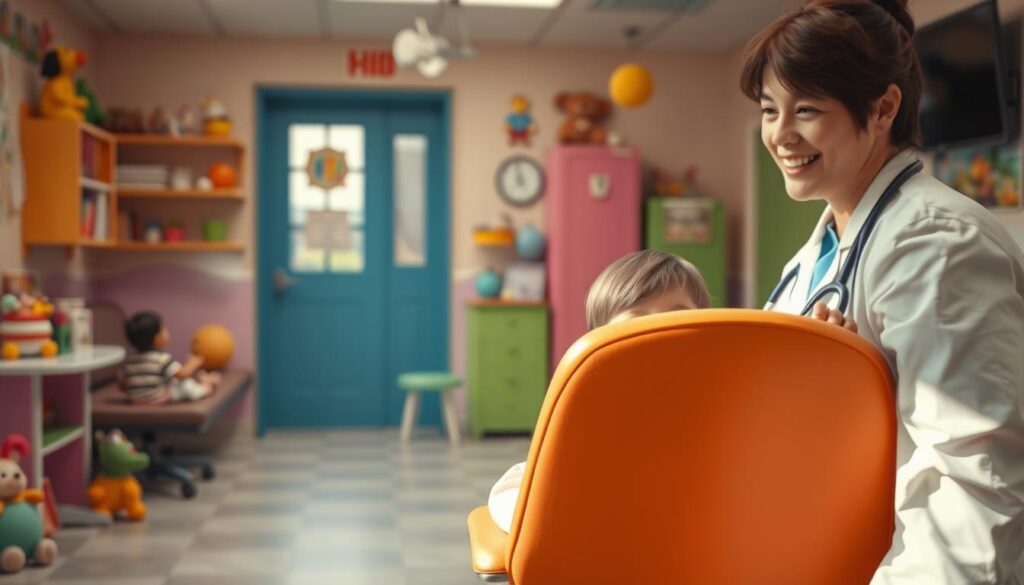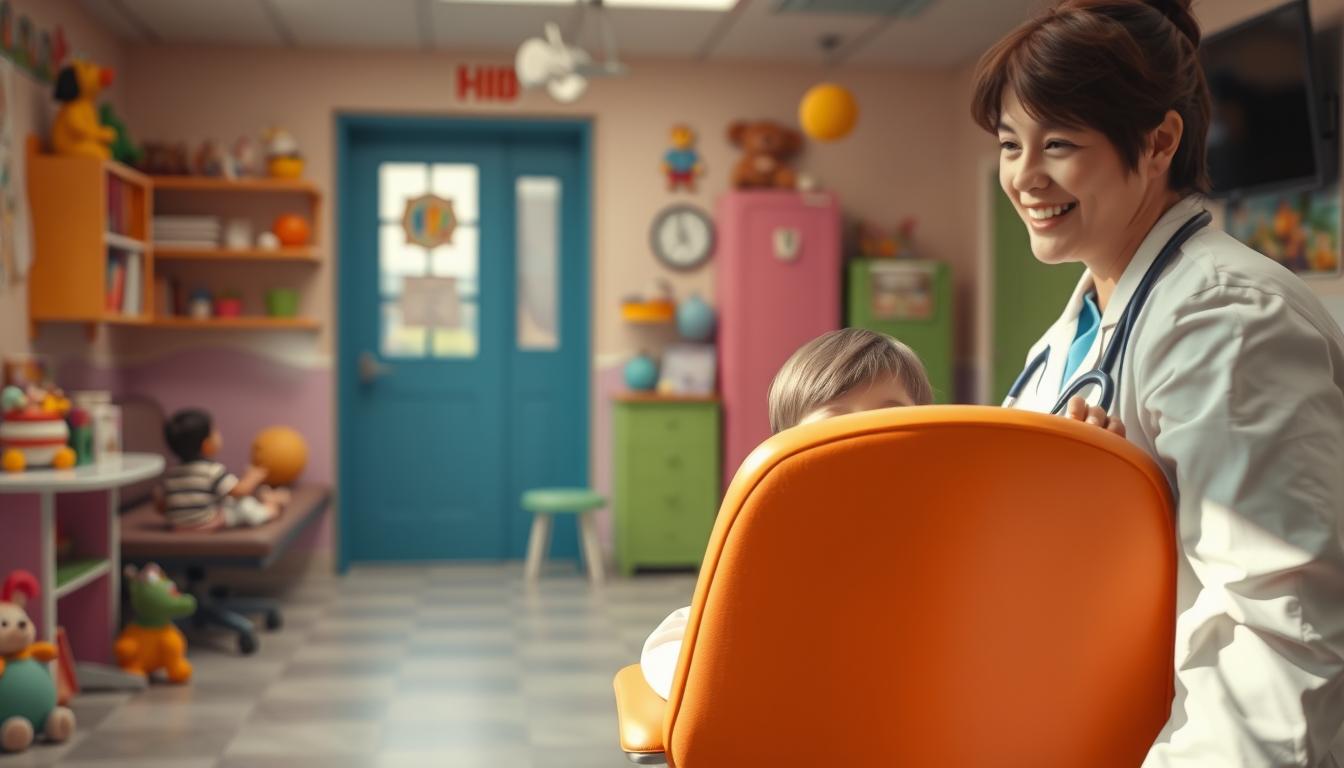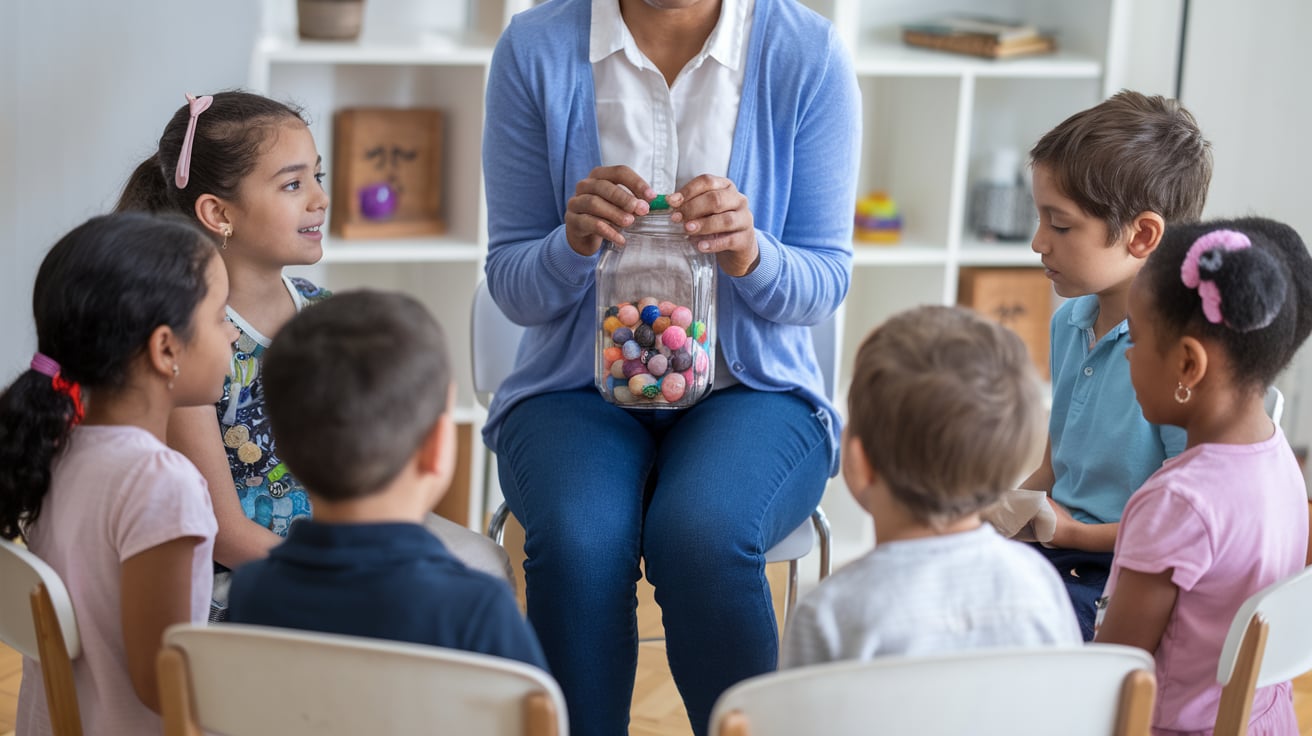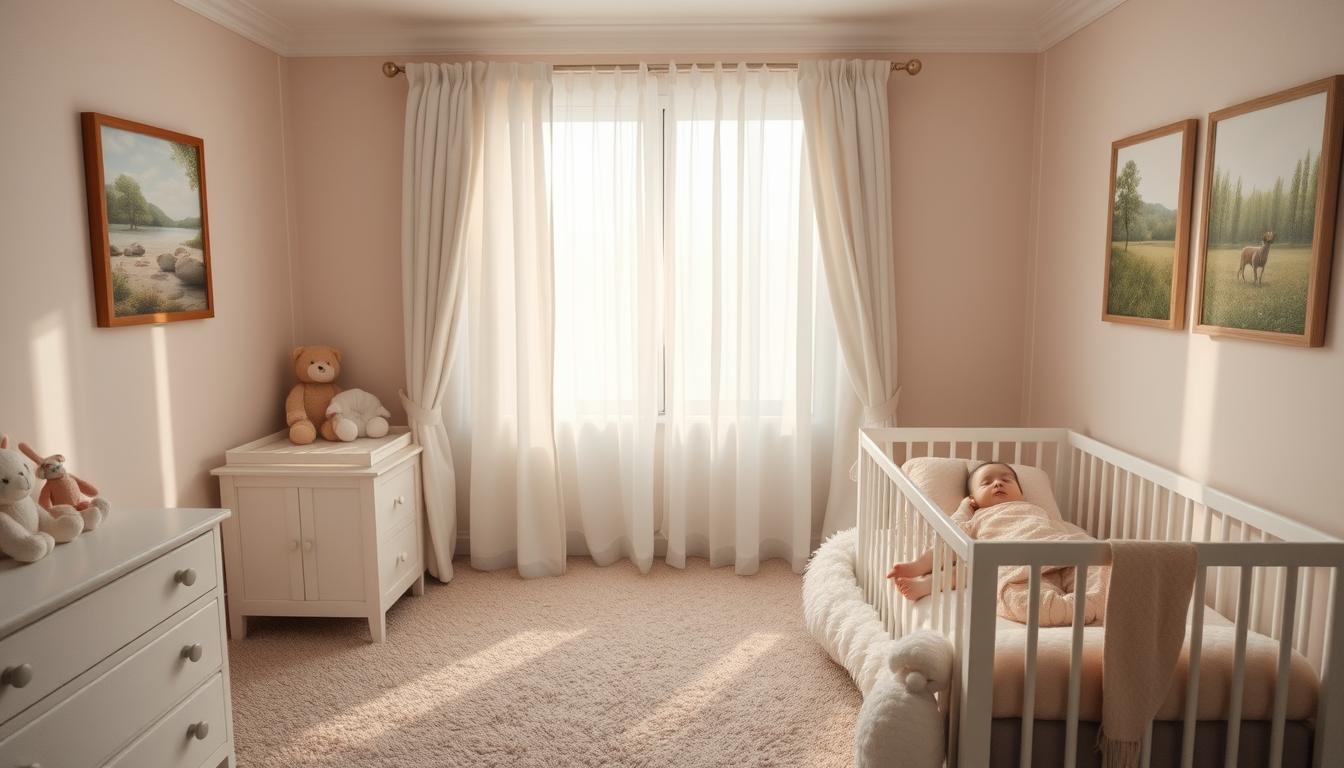Seeing your child scared at a doctor or dentist visit is tough. Many kids feel anxious about these visits. But, you can help them feel better and build a good relationship with healthcare workers.
This guide will show you how to help kids face their fears. We’ll look at ways to make their medical visits less scary and more comfortable. This way, they can have better experiences in the future.

Helping Kids Overcome Fear of Doctors or Dentists
Key Takeaways
- Understanding the root causes of medical anxiety in children is crucial for effective intervention.
- Practical techniques like breathing exercises, distraction methods, and positive reinforcement can help manage fear during appointments.
- Building trust between children and healthcare providers is essential for reducing anxiety and creating a more positive healthcare experience.
- Preparing your child for medical appointments through role-playing and exposure therapy can significantly alleviate their fears.
- Parental influence and early medical experiences play a significant role in shaping a child’s perception of healthcare professionals.
Understanding White Coat Syndrome in Children
Seeing a white coat or a doctor’s office can make our kids feel uneasy. This is called “white coat syndrome.” Healthcare professionals face this when treating young patients. Knowing what triggers it, its effects, and symptoms helps us support our kids and ease their medical fears.
Common Triggers of Medical Anxiety
Children’s fear of doctors or dentists comes from many things. These include:
- Past painful or unpleasant medical procedures
- Unfamiliar or intimidating medical equipment
- Separation from parents or caregivers during appointments
- Sensory overload from bright lights, strange sounds, or strong smells
- Perceived loss of control over their own bodies and healthcare experiences
How Fear Affects Children’s Healthcare Experience
White coat syndrome can make healthcare tough for kids. They might not cooperate, resist exams, or avoid doctors. This can cause delayed diagnoses and missed care, leading to mistrust of healthcare providers.
Recognising Physical and Emotional Symptoms
Spotting white coat syndrome in kids is key. Physical signs include a fast heartbeat, sweating, trembling, or nausea. Emotionally, they might show anxiety by crying, clinging, or saying they’re scared.
| Physical Symptoms | Emotional Symptoms |
|---|---|
| Rapid heartbeat Sweating Trembling Nausea | Anxiety Crying Clinging to parents Verbal expressions of fear |
By spotting these signs, parents and doctors can make medical visits better. This helps kids feel more at ease and encourages them to seek the care they need.
Fear of Doctors or Dentists for Kids: Root Causes Explained
It’s important for parents and healthcare providers to know why kids might be scared of doctors or dentists. This knowledge helps us tackle these fears more effectively. Let’s explore the main reasons why kids might fear these places.
Past negative experiences can be a big reason. If a child had a bad time at the dentist or doctor before, they might be scared to go back. The strange sights, sounds, and smells of these places can also make kids feel uneasy.
How parents feel about doctors and dentists matters too. Kids often take cues from their parents. If a parent is nervous or hesitant, the child might feel the same way.
- Parents can help by being calm and showing kids that medical visits are okay.
- The look and feel of a doctor’s office can also affect how comfortable a child feels.
“Addressing the root causes of dental anxiety in kids and childhood medical fears is essential for ensuring positive healthcare experiences and promoting lifelong wellness.”
Knowing these reasons helps parents and doctors create a safe and caring space. This can help kids feel better about going to the doctor or dentist.
The Impact of Early Medical Experiences on Children
Early medical experiences can deeply affect a child’s view of healthcare. Past traumas, environmental factors, and parental influence all play a part. They shape how a child sees doctors, dentists, and medical procedures.
Past Traumatic Experiences
A child’s past negative experiences with healthcare can be very impactful. For example, a painful injection or a bad hospital stay can leave a mark. These experiences can make a child more fearful of medical care in the future.
Environmental Factors
The setting of a healthcare place can also cause anxiety in children. Bright lights, strange sounds, and the smell of a doctor’s office can be overwhelming. These factors can make a child feel uneasy and question doctor-patient trust for youngsters.
Parental Influence on Medical Anxiety
Parents and caregivers have a big role in shaping a child’s views on healthcare. If parents show fear or anxiety about medical visits, children may feel the same way. However, if parents are positive and supportive, it can help reduce a child’s medical anxiety.
It’s important for healthcare providers and parents to understand how these factors affect children. By addressing these issues, we can help create a more positive environment for young patients. This way, we can help overcoming childhood medical fears together.
Building Trust Between Children and Healthcare Providers
It’s vital to build a good relationship between kids and their doctors. This trust helps young patients feel at ease and open up. It also makes them more likely to follow their treatment plans, leading to better health.
Doctors can start by making the clinic welcoming. This means using bright colors, toys, and activities. Staff should also be friendly and good at talking to kids.
Good communication is key. Doctors should listen to kids, answer their questions clearly, and involve them in decisions. Using simple language helps reduce pediatric anxiety and makes visits less scary.
It’s also important to work well with the child’s family. This helps everyone support the child’s care together.
“The key to building trust with young patients is creating a warm, welcoming environment and communicating in a way that makes them feel heard and understood,” says Dr. Emma Watkins, a renowned pediatrician. “When children feel safe and respected, they are more likely to be open and cooperative during medical visits.”
By focusing on the emotional needs of young patients, doctors can make medical visits positive. This builds trust and respect for the long term.
TO WATCH VIDEO CLICK HERE
| Strategies for Building Trust | Benefits for Children |
|---|---|
| Create a child-friendly environment Communicate effectively and listen actively Involve parents or guardians in the process Demonstrate empathy and understanding | Reduced anxiety and fear of medical visits Increased willingness to cooperate and engage in treatment Improved overall health outcomes Positive associations with healthcare providers |
Practical Strategies for Managing Dental Anxiety
Going to the dentist can scare many kids, causing dental anxiety in kids. But, with the right coping strategies for kids’ medical visits, parents and dentists can help. They can make dental visits less scary and more positive.
Breathing Exercises for Kids
Deep breathing can calm kids during dental visits. Tell your child to breathe slowly, in through the nose and out through the mouth. Make it fun by having them blow bubbles or feathers while they breathe.
Distraction Techniques During Procedures
- Bring a favorite toy, book, or movie to keep their mind occupied during the appointment.
- Play music or videos they enjoy to create a calming environment.
- Encourage your child to talk about their hobbies or interests to shift their focus.
Positive Reinforcement Methods
Praising your child for being brave and well-behaved at the dentist helps a lot. Consider giving small rewards, like stickers or treats, to celebrate their bravery. This encourages them to keep being brave.
“Helping children feel in control and empowered during their dental visits is key to managing dental anxiety in kids.”
By using these coping strategies for kids’ medical visits, we can make dental visits better for kids. Parents and dentists can create a supportive and positive environment. This makes dental appointments less stressful for children.
Preparing Your Child for Medical Appointments
Preparing your child for healthcare appointments can greatly improve their experience. It can also reduce their fear of doctors or dentists. By being proactive, you can help your child feel more comfortable and confident during these visits.
Start by having open and honest talks about the upcoming appointment. Explain what will happen in a way your child can understand. Let them know it’s okay to feel a bit scared.
- Discuss the purpose of the appointment and what the healthcare provider will do.
- Explain any procedures or tests that may be involved, using simple terms.
- Reassure your child that the healthcare team is there to help and keep them safe.
Involve your child in the preparation process. Let them choose a special toy or comfort item to bring. Let them help pack a small bag with necessary items. This gives them a sense of control and makes the experience more familiar.
Teach your child relaxation techniques, like deep breathing exercises. Playing medical roles at home can also help them get used to the healthcare setting.
By preparing your child for healthcare appointments, you can reduce their fear. This ensures a positive and cooperative experience. With patience and the right strategies, your child can learn to face medical visits with confidence and trust.
Role-Playing and Exposure Therapy Techniques
Helping kids get over their fear of doctors or dentists is tough. But, there are good ways to help. Role-playing and exposure therapy can make a big difference. They help kids get used to the doctor’s office and what happens there.
Medical Play Activities at Home
Playing doctor at home is a great idea. Kids can get to know medical tools and what doctors do in a safe place. They can use toy medical kits and pretend to be doctors or nurses. This makes them feel more at ease with doctor visits.
Practice Visits to Healthcare Settings
Going to the doctor or dentist before the real visit is also helpful. Kids can get used to the place and the people there. Doctors and dentists can explain what they do and let kids play or talk, building trust.
Using Toys to Simulate Medical Procedures
Toys and dolls can also help. Kids can practice using medical tools on their dolls or stuffed animals. This makes them feel more okay with getting medical treatment themselves.
By using these methods, parents and doctors can help kids feel better about going to the doctor. This way, kids can learn to face their fears and feel more positive about medical visits.
Conclusion
Helping kids get over their fear of doctors or dentists is a big job. It needs a mix of trust building, teaching coping skills, and making healthcare visits positive. By knowing why kids get anxious, parents and doctors can make things better.
Teaching kids to breathe deeply, use distractions, and practice with role-plays helps a lot. It gives them ways to handle their feelings when they’re at the doctor. Doctors also play a big part by being kind, trustworthy, and making each visit a chance to learn.
With time, patience, and support, kids can beat their fear. This means they’ll have better health for their whole life. By focusing on helping kids overcome fear of doctors or dentists and teaching them how to cope, we make sure they get the care they need without worry.
TO SEE MORE TOPICS CLICK HERE
FAQ
What is white coat syndrome in children and how does it affect their healthcare experiences?
White coat syndrome is when kids get really scared at doctor’s offices or hospitals. This fear can make it hard for them to do well during exams and treatments.
What are the common triggers of medical anxiety in kids?
Kids often get scared because of new places, medical tools, bad past experiences, or not understanding what’s happening. If parents are worried too, it can make things worse.
How can parents and caregivers recognise the physical and emotional symptoms of medical anxiety in children?
Signs of medical anxiety in kids include a fast heart rate, sweating, and feeling sick. They might also cry, cling to parents, or say they’re scared. Spotting these signs helps parents support their kids.
What are the underlying causes of fear of doctors or dentists in kids?
Kids might fear doctors or dentists because of bad past experiences, not knowing what to expect, or what their parents think. Knowing why they’re scared helps find ways to help them feel better.
How do early medical experiences shape children’s attitudes towards healthcare?
Early experiences, good or bad, shape how kids feel about going to the doctor. Things like scary events, the environment, and what parents say can make kids anxious.
What strategies can healthcare providers use to build trust with their young patients?
Doctors can make kids feel safe by making the place friendly, talking clearly, and using words they can understand. Letting kids help decide things and asking questions can also help them feel better.
How can parents help their children manage dental anxiety?
Parents can teach kids to breathe deeply, use distractions, and praise them for being brave. Taking them to the dentist before the real visit can also help them get used to it.
What steps can parents take to prepare their children for medical appointments?
Parents can talk about the doctor’s visit, answer any questions, and try to make it sound good. Letting kids help plan and understand what will happen can make them less scared.
What are some effective role-playing and exposure therapy techniques for overcoming pediatric medical anxieties?
Playing doctor at home, visiting the doctor’s office before the real visit, and using toys to show what happens can help. These activities make kids more comfortable with medical settings and less anxious.


